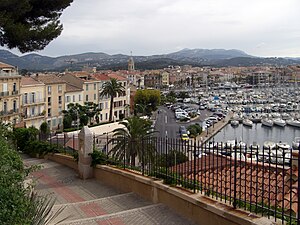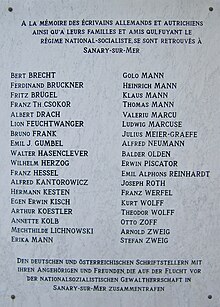Sanary-sur-Mer
| Sanary-sur-Mer | ||
|---|---|---|

|
|
|
| region | Provence-Alpes-Cote d'Azur | |
| Department | Var | |
| Arrondissement | Toulon | |
| Canton | Ollioules | |
| Community association | Sud Sainte Baume | |
| Coordinates | 43 ° 7 ' N , 5 ° 48' E | |
| height | 0-446 m | |
| surface | 19.23 km 2 | |
| Residents | 16,605 (January 1, 2017) | |
| Population density | 863 inhabitants / km 2 | |
| Post Code | 83110 | |
| INSEE code | 83123 | |
| Website | www.sanarysurmer.com | |
 Sanary-sur-Mer, port and old town |
||
Sanary-sur-Mer ( Provence Sant Nari de Mar ) is a French municipality with 16,605 inhabitants (at January 1, 2017) in the Var department in the region of Provence-Alpes-Cote d'Azur . It belongs to the canton of Ollioules in the arrondissement of Toulon .
geography
Sanary is a small town on the Mediterranean coast in the south of France not far from Toulon in the east and Bandol in the west.
history
Sanary was founded as San Nazari in 1035 . The original Provencal name was changed to Sanary-sur-Mer in 1890.
In the 12th century there was a convent of the Saint-Victor Abbey in Marseille , which was dedicated to Saint Saint Nazaire , at what is now the port . At the end of the 13th century the "Tour Romane", known under its current name, was built and served as a defense tower. 1436 built King René I , a small garrison , whose tower it as a sign of royal privilege, a dovecote was. Today the tower is integrated into a group of buildings, the “Hotel de la Tour”, which housed German emigrants during the rule of the National Socialists . The Frédéric Dumas Museum has been located in the building since 1990 .
As early as 1907, the poet André Salmon discovered Provence and the coast between Marseille and Toulon and settled in Sanary. The painter Moise Kisling, who was friends with the Salmon couple, joined them . The painter Rudolf Levy spent the summer months in Sanary-sur-Mer. Above all, he appreciated the simplicity of the residents and the wonderful landscape. After the First World War , many painters and writers from all over Europe settled here and in the vicinity, including Aldous Huxley and Julius Meier-Graefe with his partner Anne-Marie Epstein, who received the first German emigrants.
In the years after the National Socialists came to power in Germany, many German emigrants stayed in the small town on the Mediterranean Sea. Since then, the city has been an important center of exile . The most famous exiles included (in alphabetical order) Bertolt Brecht , Ferdinand Bruckner , Franz Theodor Csokor , Albert Drach , Lion and Marta Feuchtwanger , Bruno Frank , Walter Hasenclever , Franz and Helen Hessel , Alfred Kantorowicz , Hermann Kesten , Egon Erwin Kisch , Arthur Koestler , Annette Kolb , the brothers Golo and Klaus Mann , their parents Katja and Thomas Mann and his brother Heinrich Mann , Ludwig Marcuse , Erwin Piscator , Anton Räderscheidt , Joseph Roth , Ilse Salberg , Franz Werfel and Alma Mahler-Werfel , Friedrich Wolf , Arnold Zweig and Stefan Zweig .
During the Second World War, Sanary was also the residence of Jacques-Yves Cousteau , alongside Émile Gagnan co-inventor of the modern regulator . There he owned a house called "Villa Baobab", where he could protect his invention from being attacked by the German occupiers. In 1943 the first diving attempts were carried out together with Philippe Tailliez in Bandol. Later, these two diving pioneers formed a well-known trio nicknamed Les Trois Mousquemers, along with Frédéric Dumas , who had lived in Sanary since childhood . Dumas invented many diving equipment (underwater harpoon, diving mask , buoyancy compensator, etc.)
Attractions
- Notre-Dame-de-Pitié chapel : from the chapel, built in 1560 on a hill in the west of the city, you have a beautiful view over the bay of Sanary with the hills of Toulon in the background and the coast to the Îles des Embiez , behind which the Cap Sicié rises.
- Saint Nazaire Church : A neo-Gothic structure that replaced the old Romanesque church from the 16th century at the end of the 19th century.
- The "Romanesque Tower" ( Tour romane ) was built in the Middle Ages.
- Tour of the former residences of exiled artists.
Town twinning
Sanary maintains partnerships with Luino in Italy , Kościerzyna in Poland , Bad Säckingen in Germany , Purkersdorf in Austria and Noginsk in Russia .
Personalities
- Ange Barde (* 1969), entrepreneur and racing car driver
See also
literature
- Manfred Flügge : Against my will in paradise. German writers in exile in Sanary-sur-Mer (= assembly paperbacks 8024). Aufbau-Taschenbuch-Verlag, Berlin 1996, ISBN 3-7466-8024-7 .
- Manfred Flügge: The fleeting paradise: Artists on the Côte d'Azur . Aufbau-Taschenbuch-Verlag, Berlin 2008, ISBN 3-7466-8160-X
- Gerd Koch (Ed.): Literary Life, Exile and National Socialism. Berlin - Antwerp - Sanary-sur-Mer - Lippoldsberg (= Knowledge & Practice. Vol. 64). Brandes & Apsel, Frankfurt am Main 1996, ISBN 3-86099-264-3 .
- Martin Mauthner: German Writers in French Exile. 1933-1940. Vallentine Mitchell, London et al. 2007, ISBN 978-0-85303-540-4 .
- Magali Laure Nieradka: "The Capital of German Literature". Sanary-sur-Mer as a place of exile for German-speaking writers (= forms of memory. Vol. 44). V & R Unipress, Göttingen 2010, ISBN 978-3-89971-792-1 (Also: Dissertation (University of Heidelberg) 2009).
- Pierre-Paul Sagave : Sanary, capital of German literature in exile (1933-1940). Report by a contemporary witness , in: Markus Behmer (Ed.): German Journalism in Exile 1933 to 1945: People, Positions, Perspectives; Festschrift for Ursula E. Koch . Münster: Lit, 2000, pp. 58-71
- Ville de Sanary sur Mer (ed.): Sur les pas des Allemands et des Autrichiens en exil à Sanary, 1933–1945. Ville de Sanary-sur-Mer, Sanary 2004, ISBN 2-9506150-2-3 (in three languages: French - German - English. Good summary and brief portraits of many, even less well-known, exiles in the region).
- Ulrike Voswinckel, Frank Berninger: Exile on the Mediterranean. German writer in the south of France from 1933–1941. Allitera-Verlag, Munich 2005, ISBN 3-86520-113-X .
- Heinke Wunderlich, Stefanie Menke: Sanary-sur-Mer. German literature in exile (= Heinrich Heine Institute . Archive, library, museum. Vol. 5). With the collaboration of Gisela Klemt, Thomas Lambertz and Heidemarie Vahl. Metzler, Stuttgart et al. 1996, ISBN 3-476-01440-1 .
Web links
- Official website of the city (French)
- Sanary-sur-Mer - capital of German literature on arts in exile
- The forced paradise , Frankfurter Rundschau , October 16, 2017



